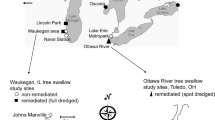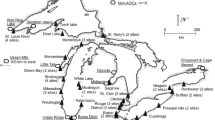Abstract
Tree swallow (Tachycineta bicolor) eggs and nestlings were collected from 16 sites across the Great Lakes to quantify normal annual variation in total polychlorinated biphenyl (PCB) exposure and to validate the sample size choice in earlier work. A sample size of five eggs or five nestlings per site was adequate to quantify exposure to PCBs in tree swallows given the current exposure levels and variation. There was no difference in PCB exposure in two randomly selected sets of five eggs collected in the same year, but analyzed in different years. Additionally, there was only modest annual variation in exposure, with between 69% (nestlings) and 73% (eggs) of sites having no differences between years. There was a tendency, both statistically and qualitatively, for there to be less exposure in the second year compared to the first year.

Similar content being viewed by others
References
Custer, T. W., Custer, C. M., & Stromborg, K. L. (1997). Distribution of organochlorine contaminants in double-crested cormorant eggs and sibling embryos. Environmental Toxicology and Chemistry, 16, 1646–1649.
Custer, C. M., Custer, T. W., Allen, P. D., Stromborg, K. L., & Melancon, M. J. (1998). Reproduction and environmental contamination in tree swallows nesting in the Fox River drainage and Green Bay, Wisconsin, USA. Environmental Toxicology and Chemistry, 17, 1786–1798.
Custer, C. M., Custer, T. W., Dummer, P. M., & Munney, K. L. (2003). Exposure and effects of chemical contaminants on tree swallows nesting along the Housatonic River, Berkshire County, Massachusetts, USA, 1998–2000. Environmental Toxicology and Chemistry, 22, 1605–1621.
Custer, C. M., Custer, T. W., Hines, J. E., Nichols, J. D., & Dummer, P. M. (2007). Adult tree swallow (Tachycineta bicolor) survival on the polychlorinated biphenyl-contaminated Housatonic River, Massachusetts, USA. Environmental Toxicology and Chemistry, 26, 1056–1065.
Custer, C. M., Custer, T. W., Dummer, P. M., Goldberg, G., & Franson, J. C. (2016). Concentrations and spatial patterns of organic contaminants in tree swallow (Tachycineta bicolor) eggs at United States and binational Great Lakes Areas of Concern, 2010–2015. Environmental Toxicology and Chemistry, 35, 3071–3092.
Custer, T. W., Custer, C. M., Dummer, P. M., Goldberg, G., Franson, J. C., & Erickson, R. A. (2017). Organic contamination in tree swallow (Tachycineta bicolor) nestlings at United States and Binational Great Lakes Areas of Concern. Environmental Toxicology and Chemistry, 36, 735–748.
Heinz, G. H., Miller, D. S., Ebert, B. J., & Stromborg, K. L. (1994). Declines in organochlorines in eggs of red-breasted mergansers from Lake Michigan, 1977–1978 versus 1990. Environmental Monitoring and Assessment, 33, 175–182.
Robertson, R. J., Stutchbury, B. J., & Cohen, R. R. (1992). Tree swallow. In A. Poole, P. Stettenheim, & F. Gill (Eds.), The Birds of North America, No. 11. Philadelphia: Academy of Natural Sciences and American Ornithologists Union.
Stapleton, M. K., & Robertson, R. J. (2006). Female tree swallow home-range movements during their fertile period as revealed by radio-tracking. The Wilson Journal of Ornithology, 118, 502–507.
US Environmental Protection Agency. (1999). Method 1668 revision A: chlorinated biphenyl congeners in water soil sediment and tissue by HRGC/HRMS, EPA No. 821R00002, 133 pp. Available from: http://www.epa.gov/Region3/1668a.pdf.
Winkler, D. W., & Allen, P. E. (1996). The seasonal decline in tree swallow clutch size: physiological constraint or strategic adjustment? Ecology, 77, 922–932.
Funding
This study was funded by the Great Lakes Restoration Initiative and the Environmental Health Mission Area of USGS.
Author information
Authors and Affiliations
Corresponding author
Ethics declarations
Conflict of interest
The authors declare that they have no conflict of interest.
Ethical approval
All procedures performed involving animals were approved by, and in accordance with, the ethical standards of the institution at which the studies were conducted.
Rights and permissions
About this article
Cite this article
Custer, C.M., Custer, T.W., Dummer, P.M. et al. Annual variation in polychlorinated biphenyl (PCB) exposure in tree swallow (Tachycineta bicolor) eggs and nestlings at Great Lakes Restoration Initiative (GLRI) study sites. Environ Monit Assess 190, 227 (2018). https://doi.org/10.1007/s10661-018-6617-3
Received:
Accepted:
Published:
DOI: https://doi.org/10.1007/s10661-018-6617-3




